Governance and Ethics: Examining Patient Rights and Ethical Issues
VerifiedAdded on 2023/06/10
|12
|3337
|496
Report
AI Summary
This report provides an analysis of governance and ethics in healthcare, focusing on patient rights and the ethical dilemmas that arise between patient autonomy and medical paternalism. It explores issues such as respecting patient autonomy, legal considerations, and ethical concerns, particularly the conflict between a patient's right to make informed decisions about their treatment and a healthcare professional's duty to provide the best possible care. The report also examines potential solutions to these ethical dilemmas, including negotiating differences of opinion, creating policies for healthcare institutions, examining patient perspectives, and increasing public awareness. It acknowledges the limitations of these solutions and emphasizes the importance of respecting legal rights while addressing the complex ethical considerations in healthcare.

Governance and Ethics
Student’s Name
8/11/2018
Student’s Name
8/11/2018
Paraphrase This Document
Need a fresh take? Get an instant paraphrase of this document with our AI Paraphraser
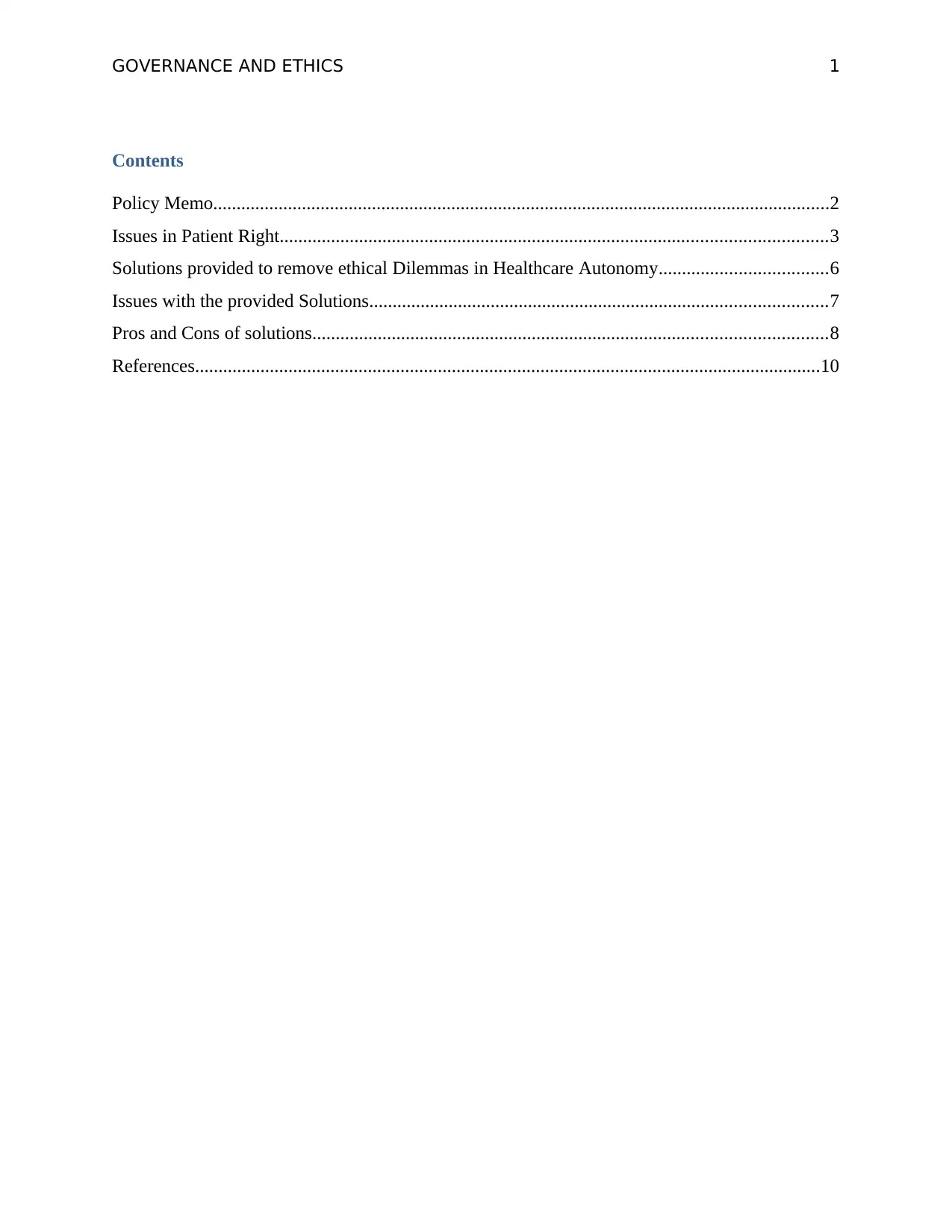
GOVERNANCE AND ETHICS 1
Contents
Policy Memo....................................................................................................................................2
Issues in Patient Right.....................................................................................................................3
Solutions provided to remove ethical Dilemmas in Healthcare Autonomy....................................6
Issues with the provided Solutions..................................................................................................7
Pros and Cons of solutions..............................................................................................................8
References......................................................................................................................................10
Contents
Policy Memo....................................................................................................................................2
Issues in Patient Right.....................................................................................................................3
Solutions provided to remove ethical Dilemmas in Healthcare Autonomy....................................6
Issues with the provided Solutions..................................................................................................7
Pros and Cons of solutions..............................................................................................................8
References......................................................................................................................................10
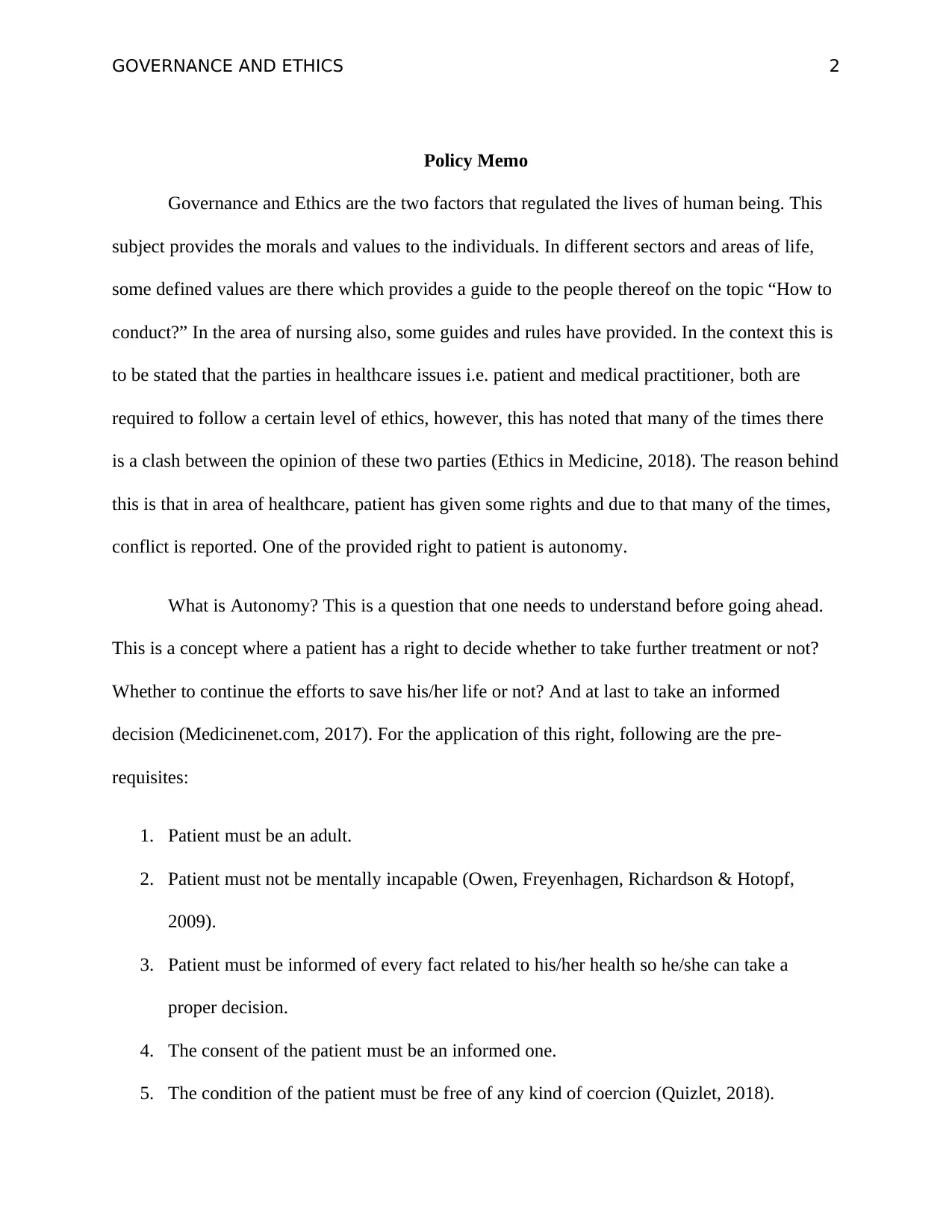
GOVERNANCE AND ETHICS 2
Policy Memo
Governance and Ethics are the two factors that regulated the lives of human being. This
subject provides the morals and values to the individuals. In different sectors and areas of life,
some defined values are there which provides a guide to the people thereof on the topic “How to
conduct?” In the area of nursing also, some guides and rules have provided. In the context this is
to be stated that the parties in healthcare issues i.e. patient and medical practitioner, both are
required to follow a certain level of ethics, however, this has noted that many of the times there
is a clash between the opinion of these two parties (Ethics in Medicine, 2018). The reason behind
this is that in area of healthcare, patient has given some rights and due to that many of the times,
conflict is reported. One of the provided right to patient is autonomy.
What is Autonomy? This is a question that one needs to understand before going ahead.
This is a concept where a patient has a right to decide whether to take further treatment or not?
Whether to continue the efforts to save his/her life or not? And at last to take an informed
decision (Medicinenet.com, 2017). For the application of this right, following are the pre-
requisites:
1. Patient must be an adult.
2. Patient must not be mentally incapable (Owen, Freyenhagen, Richardson & Hotopf,
2009).
3. Patient must be informed of every fact related to his/her health so he/she can take a
proper decision.
4. The consent of the patient must be an informed one.
5. The condition of the patient must be free of any kind of coercion (Quizlet, 2018).
Policy Memo
Governance and Ethics are the two factors that regulated the lives of human being. This
subject provides the morals and values to the individuals. In different sectors and areas of life,
some defined values are there which provides a guide to the people thereof on the topic “How to
conduct?” In the area of nursing also, some guides and rules have provided. In the context this is
to be stated that the parties in healthcare issues i.e. patient and medical practitioner, both are
required to follow a certain level of ethics, however, this has noted that many of the times there
is a clash between the opinion of these two parties (Ethics in Medicine, 2018). The reason behind
this is that in area of healthcare, patient has given some rights and due to that many of the times,
conflict is reported. One of the provided right to patient is autonomy.
What is Autonomy? This is a question that one needs to understand before going ahead.
This is a concept where a patient has a right to decide whether to take further treatment or not?
Whether to continue the efforts to save his/her life or not? And at last to take an informed
decision (Medicinenet.com, 2017). For the application of this right, following are the pre-
requisites:
1. Patient must be an adult.
2. Patient must not be mentally incapable (Owen, Freyenhagen, Richardson & Hotopf,
2009).
3. Patient must be informed of every fact related to his/her health so he/she can take a
proper decision.
4. The consent of the patient must be an informed one.
5. The condition of the patient must be free of any kind of coercion (Quizlet, 2018).
⊘ This is a preview!⊘
Do you want full access?
Subscribe today to unlock all pages.

Trusted by 1+ million students worldwide
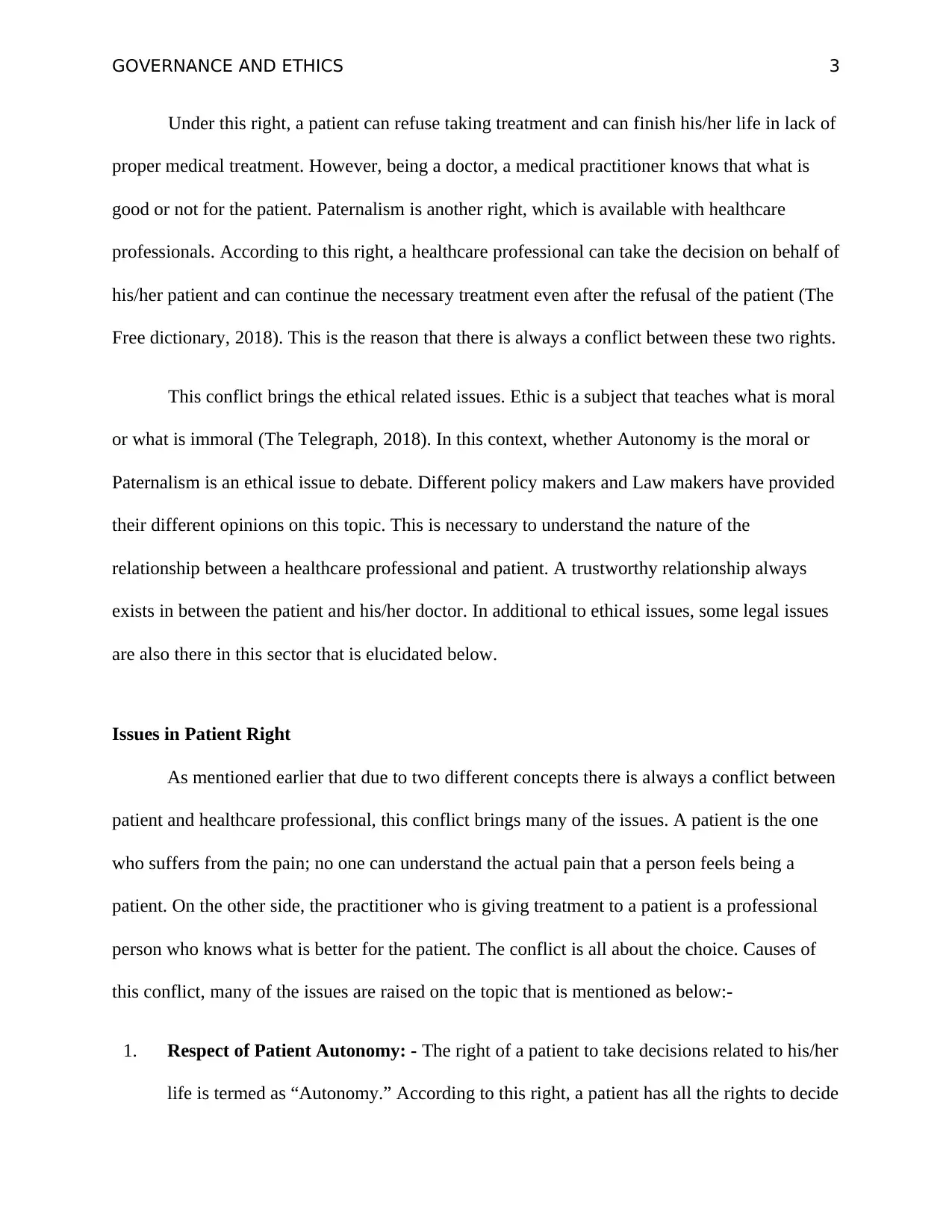
GOVERNANCE AND ETHICS 3
Under this right, a patient can refuse taking treatment and can finish his/her life in lack of
proper medical treatment. However, being a doctor, a medical practitioner knows that what is
good or not for the patient. Paternalism is another right, which is available with healthcare
professionals. According to this right, a healthcare professional can take the decision on behalf of
his/her patient and can continue the necessary treatment even after the refusal of the patient (The
Free dictionary, 2018). This is the reason that there is always a conflict between these two rights.
This conflict brings the ethical related issues. Ethic is a subject that teaches what is moral
or what is immoral (The Telegraph, 2018). In this context, whether Autonomy is the moral or
Paternalism is an ethical issue to debate. Different policy makers and Law makers have provided
their different opinions on this topic. This is necessary to understand the nature of the
relationship between a healthcare professional and patient. A trustworthy relationship always
exists in between the patient and his/her doctor. In additional to ethical issues, some legal issues
are also there in this sector that is elucidated below.
Issues in Patient Right
As mentioned earlier that due to two different concepts there is always a conflict between
patient and healthcare professional, this conflict brings many of the issues. A patient is the one
who suffers from the pain; no one can understand the actual pain that a person feels being a
patient. On the other side, the practitioner who is giving treatment to a patient is a professional
person who knows what is better for the patient. The conflict is all about the choice. Causes of
this conflict, many of the issues are raised on the topic that is mentioned as below:-
1. Respect of Patient Autonomy: - The right of a patient to take decisions related to his/her
life is termed as “Autonomy.” According to this right, a patient has all the rights to decide
Under this right, a patient can refuse taking treatment and can finish his/her life in lack of
proper medical treatment. However, being a doctor, a medical practitioner knows that what is
good or not for the patient. Paternalism is another right, which is available with healthcare
professionals. According to this right, a healthcare professional can take the decision on behalf of
his/her patient and can continue the necessary treatment even after the refusal of the patient (The
Free dictionary, 2018). This is the reason that there is always a conflict between these two rights.
This conflict brings the ethical related issues. Ethic is a subject that teaches what is moral
or what is immoral (The Telegraph, 2018). In this context, whether Autonomy is the moral or
Paternalism is an ethical issue to debate. Different policy makers and Law makers have provided
their different opinions on this topic. This is necessary to understand the nature of the
relationship between a healthcare professional and patient. A trustworthy relationship always
exists in between the patient and his/her doctor. In additional to ethical issues, some legal issues
are also there in this sector that is elucidated below.
Issues in Patient Right
As mentioned earlier that due to two different concepts there is always a conflict between
patient and healthcare professional, this conflict brings many of the issues. A patient is the one
who suffers from the pain; no one can understand the actual pain that a person feels being a
patient. On the other side, the practitioner who is giving treatment to a patient is a professional
person who knows what is better for the patient. The conflict is all about the choice. Causes of
this conflict, many of the issues are raised on the topic that is mentioned as below:-
1. Respect of Patient Autonomy: - The right of a patient to take decisions related to his/her
life is termed as “Autonomy.” According to this right, a patient has all the rights to decide
Paraphrase This Document
Need a fresh take? Get an instant paraphrase of this document with our AI Paraphraser
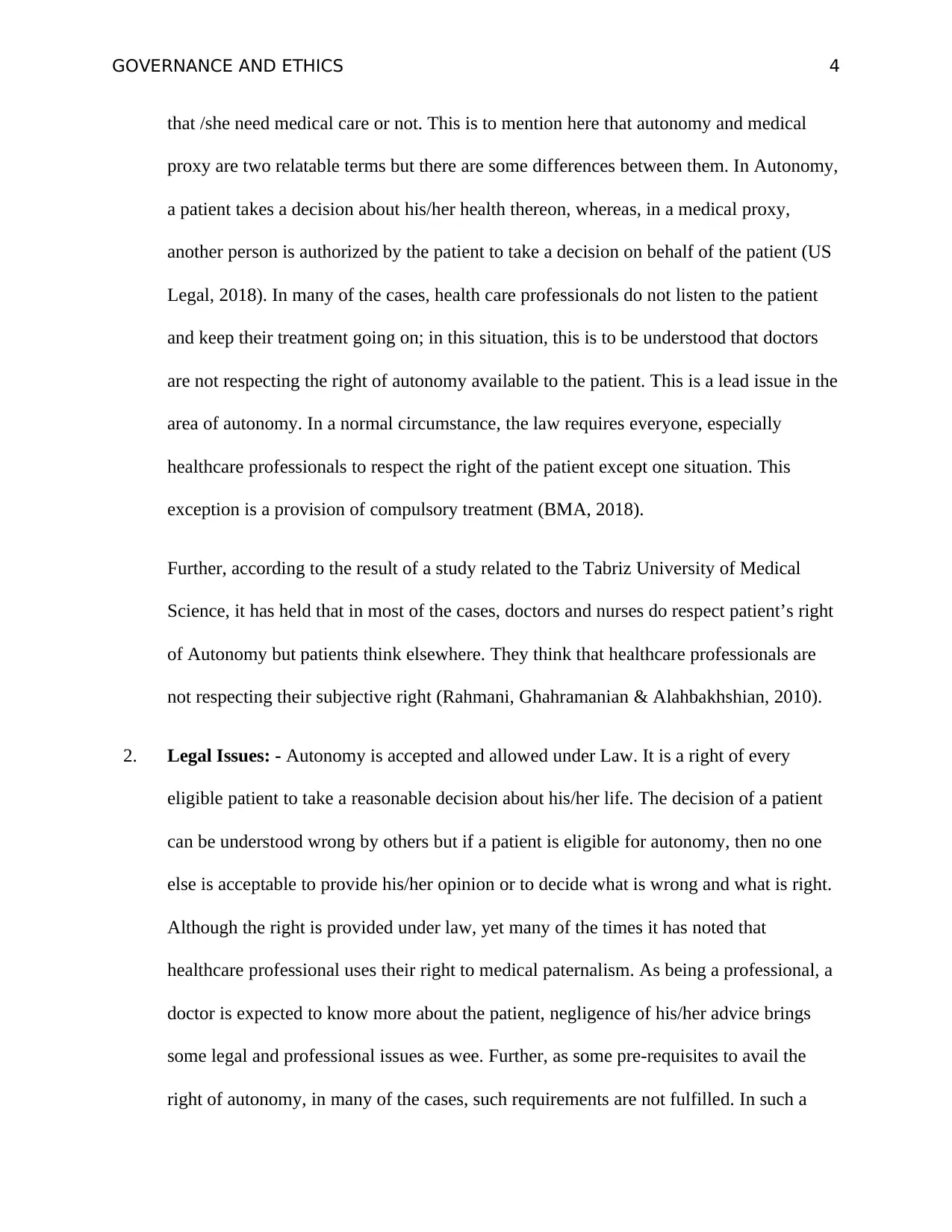
GOVERNANCE AND ETHICS 4
that /she need medical care or not. This is to mention here that autonomy and medical
proxy are two relatable terms but there are some differences between them. In Autonomy,
a patient takes a decision about his/her health thereon, whereas, in a medical proxy,
another person is authorized by the patient to take a decision on behalf of the patient (US
Legal, 2018). In many of the cases, health care professionals do not listen to the patient
and keep their treatment going on; in this situation, this is to be understood that doctors
are not respecting the right of autonomy available to the patient. This is a lead issue in the
area of autonomy. In a normal circumstance, the law requires everyone, especially
healthcare professionals to respect the right of the patient except one situation. This
exception is a provision of compulsory treatment (BMA, 2018).
Further, according to the result of a study related to the Tabriz University of Medical
Science, it has held that in most of the cases, doctors and nurses do respect patient’s right
of Autonomy but patients think elsewhere. They think that healthcare professionals are
not respecting their subjective right (Rahmani, Ghahramanian & Alahbakhshian, 2010).
2. Legal Issues: - Autonomy is accepted and allowed under Law. It is a right of every
eligible patient to take a reasonable decision about his/her life. The decision of a patient
can be understood wrong by others but if a patient is eligible for autonomy, then no one
else is acceptable to provide his/her opinion or to decide what is wrong and what is right.
Although the right is provided under law, yet many of the times it has noted that
healthcare professional uses their right to medical paternalism. As being a professional, a
doctor is expected to know more about the patient, negligence of his/her advice brings
some legal and professional issues as wee. Further, as some pre-requisites to avail the
right of autonomy, in many of the cases, such requirements are not fulfilled. In such a
that /she need medical care or not. This is to mention here that autonomy and medical
proxy are two relatable terms but there are some differences between them. In Autonomy,
a patient takes a decision about his/her health thereon, whereas, in a medical proxy,
another person is authorized by the patient to take a decision on behalf of the patient (US
Legal, 2018). In many of the cases, health care professionals do not listen to the patient
and keep their treatment going on; in this situation, this is to be understood that doctors
are not respecting the right of autonomy available to the patient. This is a lead issue in the
area of autonomy. In a normal circumstance, the law requires everyone, especially
healthcare professionals to respect the right of the patient except one situation. This
exception is a provision of compulsory treatment (BMA, 2018).
Further, according to the result of a study related to the Tabriz University of Medical
Science, it has held that in most of the cases, doctors and nurses do respect patient’s right
of Autonomy but patients think elsewhere. They think that healthcare professionals are
not respecting their subjective right (Rahmani, Ghahramanian & Alahbakhshian, 2010).
2. Legal Issues: - Autonomy is accepted and allowed under Law. It is a right of every
eligible patient to take a reasonable decision about his/her life. The decision of a patient
can be understood wrong by others but if a patient is eligible for autonomy, then no one
else is acceptable to provide his/her opinion or to decide what is wrong and what is right.
Although the right is provided under law, yet many of the times it has noted that
healthcare professional uses their right to medical paternalism. As being a professional, a
doctor is expected to know more about the patient, negligence of his/her advice brings
some legal and professional issues as wee. Further, as some pre-requisites to avail the
right of autonomy, in many of the cases, such requirements are not fulfilled. In such a
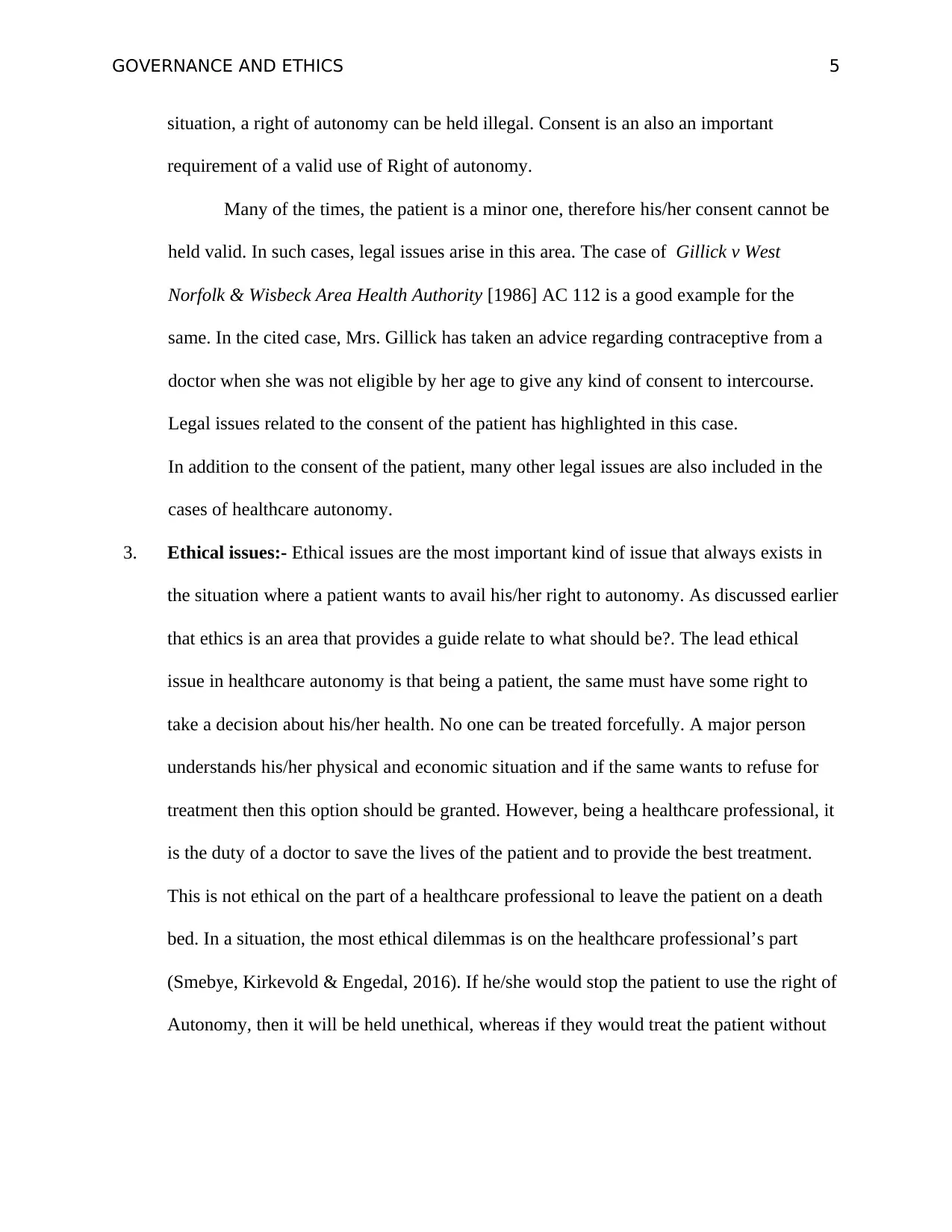
GOVERNANCE AND ETHICS 5
situation, a right of autonomy can be held illegal. Consent is an also an important
requirement of a valid use of Right of autonomy.
Many of the times, the patient is a minor one, therefore his/her consent cannot be
held valid. In such cases, legal issues arise in this area. The case of Gillick v West
Norfolk & Wisbeck Area Health Authority [1986] AC 112 is a good example for the
same. In the cited case, Mrs. Gillick has taken an advice regarding contraceptive from a
doctor when she was not eligible by her age to give any kind of consent to intercourse.
Legal issues related to the consent of the patient has highlighted in this case.
In addition to the consent of the patient, many other legal issues are also included in the
cases of healthcare autonomy.
3. Ethical issues:- Ethical issues are the most important kind of issue that always exists in
the situation where a patient wants to avail his/her right to autonomy. As discussed earlier
that ethics is an area that provides a guide relate to what should be?. The lead ethical
issue in healthcare autonomy is that being a patient, the same must have some right to
take a decision about his/her health. No one can be treated forcefully. A major person
understands his/her physical and economic situation and if the same wants to refuse for
treatment then this option should be granted. However, being a healthcare professional, it
is the duty of a doctor to save the lives of the patient and to provide the best treatment.
This is not ethical on the part of a healthcare professional to leave the patient on a death
bed. In a situation, the most ethical dilemmas is on the healthcare professional’s part
(Smebye, Kirkevold & Engedal, 2016). If he/she would stop the patient to use the right of
Autonomy, then it will be held unethical, whereas if they would treat the patient without
situation, a right of autonomy can be held illegal. Consent is an also an important
requirement of a valid use of Right of autonomy.
Many of the times, the patient is a minor one, therefore his/her consent cannot be
held valid. In such cases, legal issues arise in this area. The case of Gillick v West
Norfolk & Wisbeck Area Health Authority [1986] AC 112 is a good example for the
same. In the cited case, Mrs. Gillick has taken an advice regarding contraceptive from a
doctor when she was not eligible by her age to give any kind of consent to intercourse.
Legal issues related to the consent of the patient has highlighted in this case.
In addition to the consent of the patient, many other legal issues are also included in the
cases of healthcare autonomy.
3. Ethical issues:- Ethical issues are the most important kind of issue that always exists in
the situation where a patient wants to avail his/her right to autonomy. As discussed earlier
that ethics is an area that provides a guide relate to what should be?. The lead ethical
issue in healthcare autonomy is that being a patient, the same must have some right to
take a decision about his/her health. No one can be treated forcefully. A major person
understands his/her physical and economic situation and if the same wants to refuse for
treatment then this option should be granted. However, being a healthcare professional, it
is the duty of a doctor to save the lives of the patient and to provide the best treatment.
This is not ethical on the part of a healthcare professional to leave the patient on a death
bed. In a situation, the most ethical dilemmas is on the healthcare professional’s part
(Smebye, Kirkevold & Engedal, 2016). If he/she would stop the patient to use the right of
Autonomy, then it will be held unethical, whereas if they would treat the patient without
⊘ This is a preview!⊘
Do you want full access?
Subscribe today to unlock all pages.

Trusted by 1+ million students worldwide
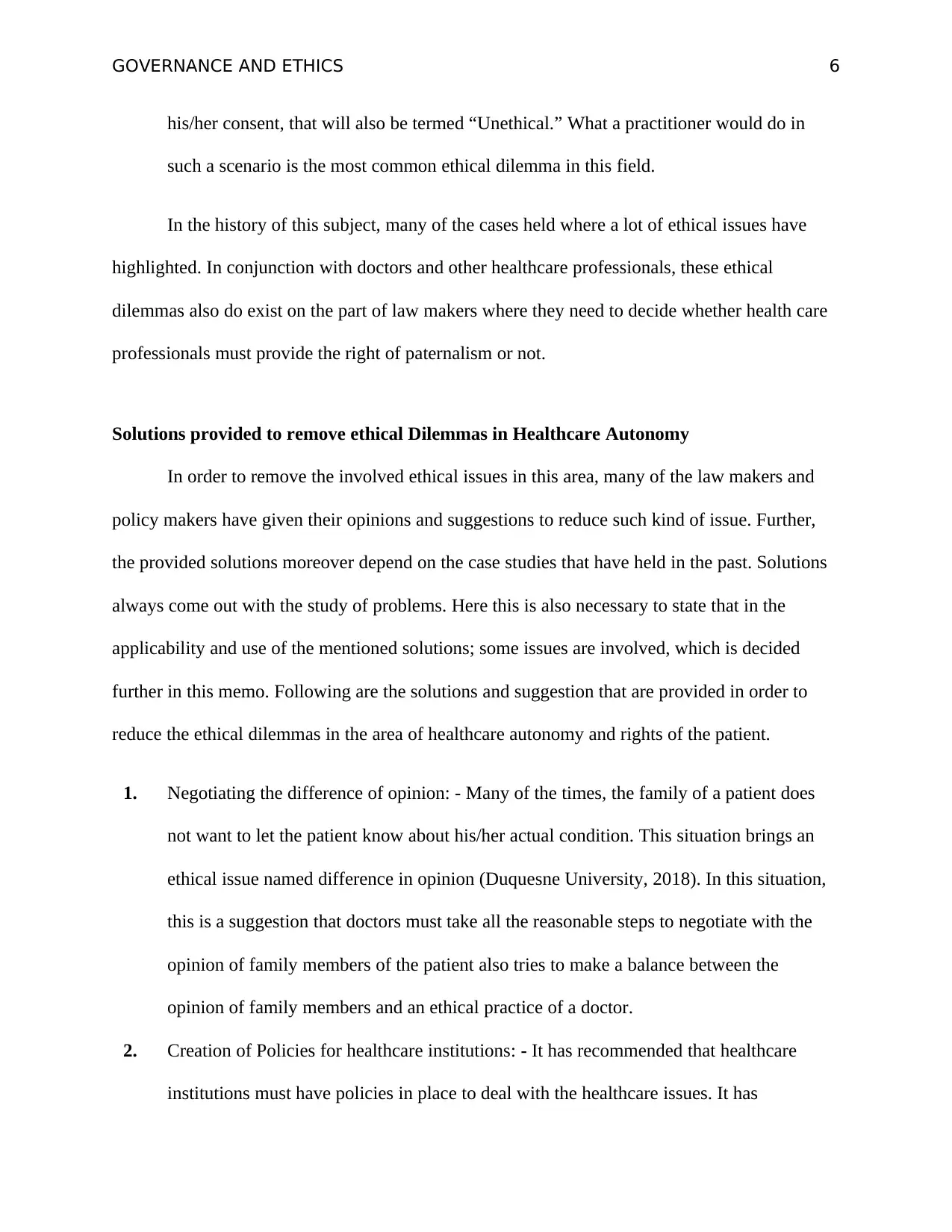
GOVERNANCE AND ETHICS 6
his/her consent, that will also be termed “Unethical.” What a practitioner would do in
such a scenario is the most common ethical dilemma in this field.
In the history of this subject, many of the cases held where a lot of ethical issues have
highlighted. In conjunction with doctors and other healthcare professionals, these ethical
dilemmas also do exist on the part of law makers where they need to decide whether health care
professionals must provide the right of paternalism or not.
Solutions provided to remove ethical Dilemmas in Healthcare Autonomy
In order to remove the involved ethical issues in this area, many of the law makers and
policy makers have given their opinions and suggestions to reduce such kind of issue. Further,
the provided solutions moreover depend on the case studies that have held in the past. Solutions
always come out with the study of problems. Here this is also necessary to state that in the
applicability and use of the mentioned solutions; some issues are involved, which is decided
further in this memo. Following are the solutions and suggestion that are provided in order to
reduce the ethical dilemmas in the area of healthcare autonomy and rights of the patient.
1. Negotiating the difference of opinion: - Many of the times, the family of a patient does
not want to let the patient know about his/her actual condition. This situation brings an
ethical issue named difference in opinion (Duquesne University, 2018). In this situation,
this is a suggestion that doctors must take all the reasonable steps to negotiate with the
opinion of family members of the patient also tries to make a balance between the
opinion of family members and an ethical practice of a doctor.
2. Creation of Policies for healthcare institutions: - It has recommended that healthcare
institutions must have policies in place to deal with the healthcare issues. It has
his/her consent, that will also be termed “Unethical.” What a practitioner would do in
such a scenario is the most common ethical dilemma in this field.
In the history of this subject, many of the cases held where a lot of ethical issues have
highlighted. In conjunction with doctors and other healthcare professionals, these ethical
dilemmas also do exist on the part of law makers where they need to decide whether health care
professionals must provide the right of paternalism or not.
Solutions provided to remove ethical Dilemmas in Healthcare Autonomy
In order to remove the involved ethical issues in this area, many of the law makers and
policy makers have given their opinions and suggestions to reduce such kind of issue. Further,
the provided solutions moreover depend on the case studies that have held in the past. Solutions
always come out with the study of problems. Here this is also necessary to state that in the
applicability and use of the mentioned solutions; some issues are involved, which is decided
further in this memo. Following are the solutions and suggestion that are provided in order to
reduce the ethical dilemmas in the area of healthcare autonomy and rights of the patient.
1. Negotiating the difference of opinion: - Many of the times, the family of a patient does
not want to let the patient know about his/her actual condition. This situation brings an
ethical issue named difference in opinion (Duquesne University, 2018). In this situation,
this is a suggestion that doctors must take all the reasonable steps to negotiate with the
opinion of family members of the patient also tries to make a balance between the
opinion of family members and an ethical practice of a doctor.
2. Creation of Policies for healthcare institutions: - It has recommended that healthcare
institutions must have policies in place to deal with the healthcare issues. It has
Paraphrase This Document
Need a fresh take? Get an instant paraphrase of this document with our AI Paraphraser
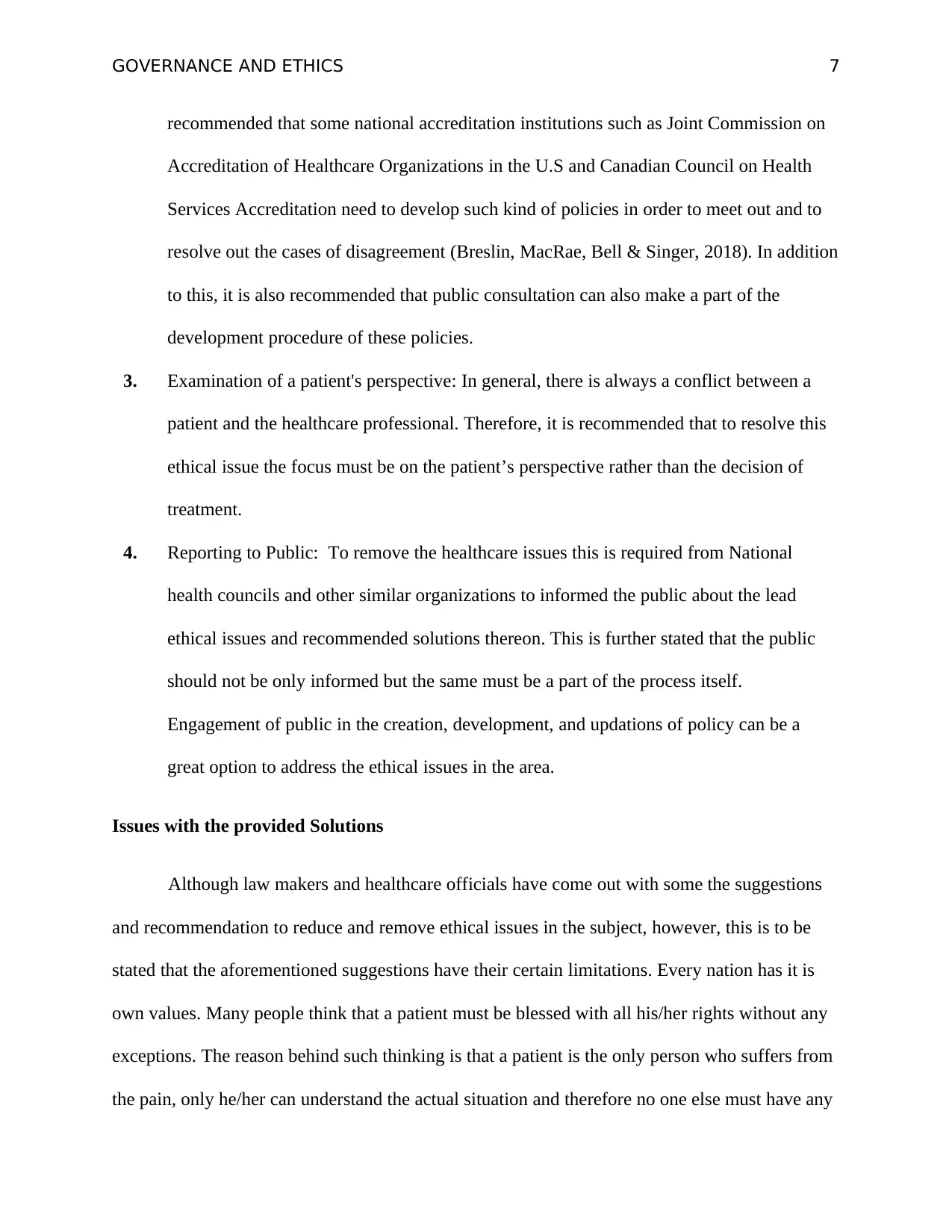
GOVERNANCE AND ETHICS 7
recommended that some national accreditation institutions such as Joint Commission on
Accreditation of Healthcare Organizations in the U.S and Canadian Council on Health
Services Accreditation need to develop such kind of policies in order to meet out and to
resolve out the cases of disagreement (Breslin, MacRae, Bell & Singer, 2018). In addition
to this, it is also recommended that public consultation can also make a part of the
development procedure of these policies.
3. Examination of a patient's perspective: In general, there is always a conflict between a
patient and the healthcare professional. Therefore, it is recommended that to resolve this
ethical issue the focus must be on the patient’s perspective rather than the decision of
treatment.
4. Reporting to Public: To remove the healthcare issues this is required from National
health councils and other similar organizations to informed the public about the lead
ethical issues and recommended solutions thereon. This is further stated that the public
should not be only informed but the same must be a part of the process itself.
Engagement of public in the creation, development, and updations of policy can be a
great option to address the ethical issues in the area.
Issues with the provided Solutions
Although law makers and healthcare officials have come out with some the suggestions
and recommendation to reduce and remove ethical issues in the subject, however, this is to be
stated that the aforementioned suggestions have their certain limitations. Every nation has it is
own values. Many people think that a patient must be blessed with all his/her rights without any
exceptions. The reason behind such thinking is that a patient is the only person who suffers from
the pain, only he/her can understand the actual situation and therefore no one else must have any
recommended that some national accreditation institutions such as Joint Commission on
Accreditation of Healthcare Organizations in the U.S and Canadian Council on Health
Services Accreditation need to develop such kind of policies in order to meet out and to
resolve out the cases of disagreement (Breslin, MacRae, Bell & Singer, 2018). In addition
to this, it is also recommended that public consultation can also make a part of the
development procedure of these policies.
3. Examination of a patient's perspective: In general, there is always a conflict between a
patient and the healthcare professional. Therefore, it is recommended that to resolve this
ethical issue the focus must be on the patient’s perspective rather than the decision of
treatment.
4. Reporting to Public: To remove the healthcare issues this is required from National
health councils and other similar organizations to informed the public about the lead
ethical issues and recommended solutions thereon. This is further stated that the public
should not be only informed but the same must be a part of the process itself.
Engagement of public in the creation, development, and updations of policy can be a
great option to address the ethical issues in the area.
Issues with the provided Solutions
Although law makers and healthcare officials have come out with some the suggestions
and recommendation to reduce and remove ethical issues in the subject, however, this is to be
stated that the aforementioned suggestions have their certain limitations. Every nation has it is
own values. Many people think that a patient must be blessed with all his/her rights without any
exceptions. The reason behind such thinking is that a patient is the only person who suffers from
the pain, only he/her can understand the actual situation and therefore no one else must have any
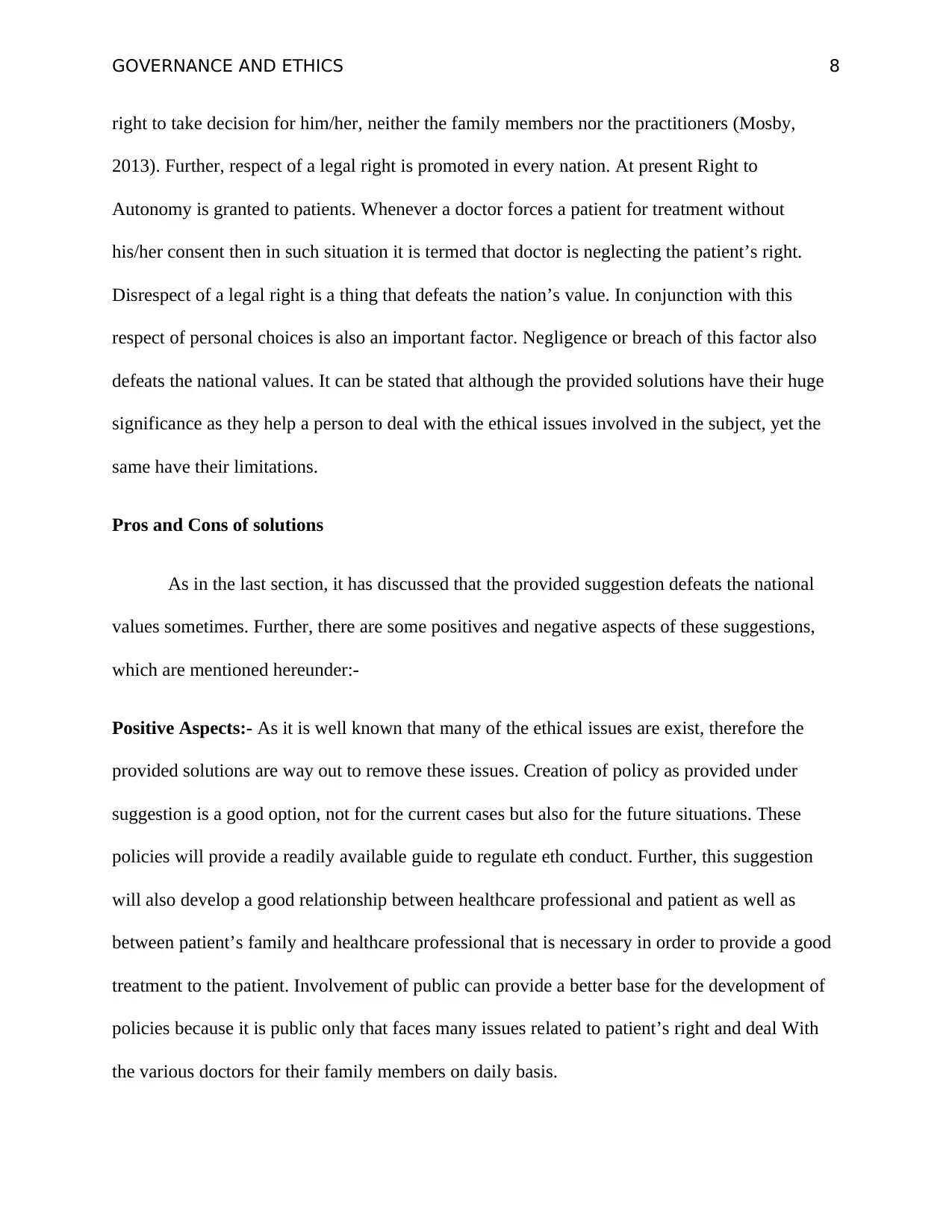
GOVERNANCE AND ETHICS 8
right to take decision for him/her, neither the family members nor the practitioners (Mosby,
2013). Further, respect of a legal right is promoted in every nation. At present Right to
Autonomy is granted to patients. Whenever a doctor forces a patient for treatment without
his/her consent then in such situation it is termed that doctor is neglecting the patient’s right.
Disrespect of a legal right is a thing that defeats the nation’s value. In conjunction with this
respect of personal choices is also an important factor. Negligence or breach of this factor also
defeats the national values. It can be stated that although the provided solutions have their huge
significance as they help a person to deal with the ethical issues involved in the subject, yet the
same have their limitations.
Pros and Cons of solutions
As in the last section, it has discussed that the provided suggestion defeats the national
values sometimes. Further, there are some positives and negative aspects of these suggestions,
which are mentioned hereunder:-
Positive Aspects:- As it is well known that many of the ethical issues are exist, therefore the
provided solutions are way out to remove these issues. Creation of policy as provided under
suggestion is a good option, not for the current cases but also for the future situations. These
policies will provide a readily available guide to regulate eth conduct. Further, this suggestion
will also develop a good relationship between healthcare professional and patient as well as
between patient’s family and healthcare professional that is necessary in order to provide a good
treatment to the patient. Involvement of public can provide a better base for the development of
policies because it is public only that faces many issues related to patient’s right and deal With
the various doctors for their family members on daily basis.
right to take decision for him/her, neither the family members nor the practitioners (Mosby,
2013). Further, respect of a legal right is promoted in every nation. At present Right to
Autonomy is granted to patients. Whenever a doctor forces a patient for treatment without
his/her consent then in such situation it is termed that doctor is neglecting the patient’s right.
Disrespect of a legal right is a thing that defeats the nation’s value. In conjunction with this
respect of personal choices is also an important factor. Negligence or breach of this factor also
defeats the national values. It can be stated that although the provided solutions have their huge
significance as they help a person to deal with the ethical issues involved in the subject, yet the
same have their limitations.
Pros and Cons of solutions
As in the last section, it has discussed that the provided suggestion defeats the national
values sometimes. Further, there are some positives and negative aspects of these suggestions,
which are mentioned hereunder:-
Positive Aspects:- As it is well known that many of the ethical issues are exist, therefore the
provided solutions are way out to remove these issues. Creation of policy as provided under
suggestion is a good option, not for the current cases but also for the future situations. These
policies will provide a readily available guide to regulate eth conduct. Further, this suggestion
will also develop a good relationship between healthcare professional and patient as well as
between patient’s family and healthcare professional that is necessary in order to provide a good
treatment to the patient. Involvement of public can provide a better base for the development of
policies because it is public only that faces many issues related to patient’s right and deal With
the various doctors for their family members on daily basis.
⊘ This is a preview!⊘
Do you want full access?
Subscribe today to unlock all pages.

Trusted by 1+ million students worldwide
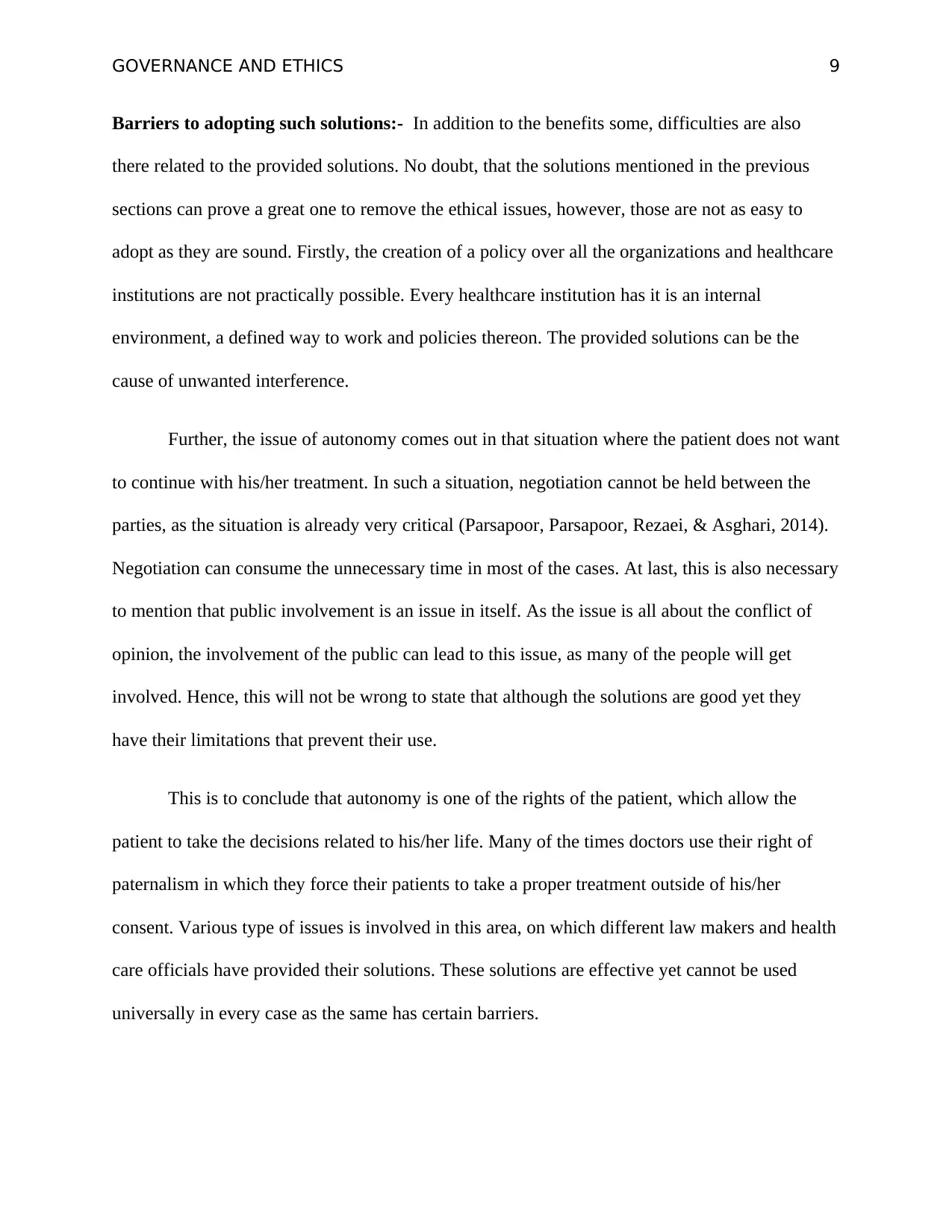
GOVERNANCE AND ETHICS 9
Barriers to adopting such solutions:- In addition to the benefits some, difficulties are also
there related to the provided solutions. No doubt, that the solutions mentioned in the previous
sections can prove a great one to remove the ethical issues, however, those are not as easy to
adopt as they are sound. Firstly, the creation of a policy over all the organizations and healthcare
institutions are not practically possible. Every healthcare institution has it is an internal
environment, a defined way to work and policies thereon. The provided solutions can be the
cause of unwanted interference.
Further, the issue of autonomy comes out in that situation where the patient does not want
to continue with his/her treatment. In such a situation, negotiation cannot be held between the
parties, as the situation is already very critical (Parsapoor, Parsapoor, Rezaei, & Asghari, 2014).
Negotiation can consume the unnecessary time in most of the cases. At last, this is also necessary
to mention that public involvement is an issue in itself. As the issue is all about the conflict of
opinion, the involvement of the public can lead to this issue, as many of the people will get
involved. Hence, this will not be wrong to state that although the solutions are good yet they
have their limitations that prevent their use.
This is to conclude that autonomy is one of the rights of the patient, which allow the
patient to take the decisions related to his/her life. Many of the times doctors use their right of
paternalism in which they force their patients to take a proper treatment outside of his/her
consent. Various type of issues is involved in this area, on which different law makers and health
care officials have provided their solutions. These solutions are effective yet cannot be used
universally in every case as the same has certain barriers.
Barriers to adopting such solutions:- In addition to the benefits some, difficulties are also
there related to the provided solutions. No doubt, that the solutions mentioned in the previous
sections can prove a great one to remove the ethical issues, however, those are not as easy to
adopt as they are sound. Firstly, the creation of a policy over all the organizations and healthcare
institutions are not practically possible. Every healthcare institution has it is an internal
environment, a defined way to work and policies thereon. The provided solutions can be the
cause of unwanted interference.
Further, the issue of autonomy comes out in that situation where the patient does not want
to continue with his/her treatment. In such a situation, negotiation cannot be held between the
parties, as the situation is already very critical (Parsapoor, Parsapoor, Rezaei, & Asghari, 2014).
Negotiation can consume the unnecessary time in most of the cases. At last, this is also necessary
to mention that public involvement is an issue in itself. As the issue is all about the conflict of
opinion, the involvement of the public can lead to this issue, as many of the people will get
involved. Hence, this will not be wrong to state that although the solutions are good yet they
have their limitations that prevent their use.
This is to conclude that autonomy is one of the rights of the patient, which allow the
patient to take the decisions related to his/her life. Many of the times doctors use their right of
paternalism in which they force their patients to take a proper treatment outside of his/her
consent. Various type of issues is involved in this area, on which different law makers and health
care officials have provided their solutions. These solutions are effective yet cannot be used
universally in every case as the same has certain barriers.
Paraphrase This Document
Need a fresh take? Get an instant paraphrase of this document with our AI Paraphraser
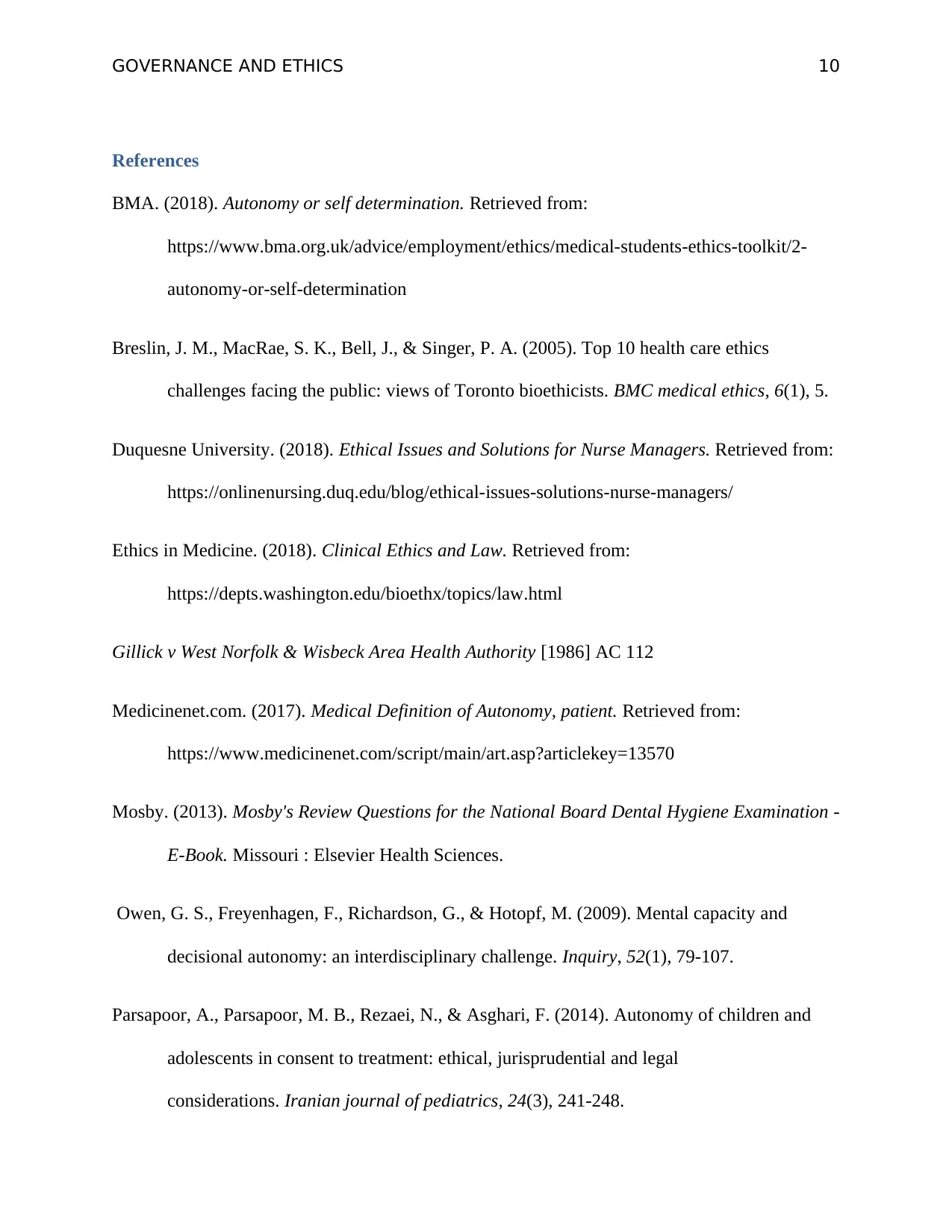
GOVERNANCE AND ETHICS 10
References
BMA. (2018). Autonomy or self determination. Retrieved from:
https://www.bma.org.uk/advice/employment/ethics/medical-students-ethics-toolkit/2-
autonomy-or-self-determination
Breslin, J. M., MacRae, S. K., Bell, J., & Singer, P. A. (2005). Top 10 health care ethics
challenges facing the public: views of Toronto bioethicists. BMC medical ethics, 6(1), 5.
Duquesne University. (2018). Ethical Issues and Solutions for Nurse Managers. Retrieved from:
https://onlinenursing.duq.edu/blog/ethical-issues-solutions-nurse-managers/
Ethics in Medicine. (2018). Clinical Ethics and Law. Retrieved from:
https://depts.washington.edu/bioethx/topics/law.html
Gillick v West Norfolk & Wisbeck Area Health Authority [1986] AC 112
Medicinenet.com. (2017). Medical Definition of Autonomy, patient. Retrieved from:
https://www.medicinenet.com/script/main/art.asp?articlekey=13570
Mosby. (2013). Mosby's Review Questions for the National Board Dental Hygiene Examination -
E-Book. Missouri : Elsevier Health Sciences.
Owen, G. S., Freyenhagen, F., Richardson, G., & Hotopf, M. (2009). Mental capacity and
decisional autonomy: an interdisciplinary challenge. Inquiry, 52(1), 79-107.
Parsapoor, A., Parsapoor, M. B., Rezaei, N., & Asghari, F. (2014). Autonomy of children and
adolescents in consent to treatment: ethical, jurisprudential and legal
considerations. Iranian journal of pediatrics, 24(3), 241-248.
References
BMA. (2018). Autonomy or self determination. Retrieved from:
https://www.bma.org.uk/advice/employment/ethics/medical-students-ethics-toolkit/2-
autonomy-or-self-determination
Breslin, J. M., MacRae, S. K., Bell, J., & Singer, P. A. (2005). Top 10 health care ethics
challenges facing the public: views of Toronto bioethicists. BMC medical ethics, 6(1), 5.
Duquesne University. (2018). Ethical Issues and Solutions for Nurse Managers. Retrieved from:
https://onlinenursing.duq.edu/blog/ethical-issues-solutions-nurse-managers/
Ethics in Medicine. (2018). Clinical Ethics and Law. Retrieved from:
https://depts.washington.edu/bioethx/topics/law.html
Gillick v West Norfolk & Wisbeck Area Health Authority [1986] AC 112
Medicinenet.com. (2017). Medical Definition of Autonomy, patient. Retrieved from:
https://www.medicinenet.com/script/main/art.asp?articlekey=13570
Mosby. (2013). Mosby's Review Questions for the National Board Dental Hygiene Examination -
E-Book. Missouri : Elsevier Health Sciences.
Owen, G. S., Freyenhagen, F., Richardson, G., & Hotopf, M. (2009). Mental capacity and
decisional autonomy: an interdisciplinary challenge. Inquiry, 52(1), 79-107.
Parsapoor, A., Parsapoor, M. B., Rezaei, N., & Asghari, F. (2014). Autonomy of children and
adolescents in consent to treatment: ethical, jurisprudential and legal
considerations. Iranian journal of pediatrics, 24(3), 241-248.
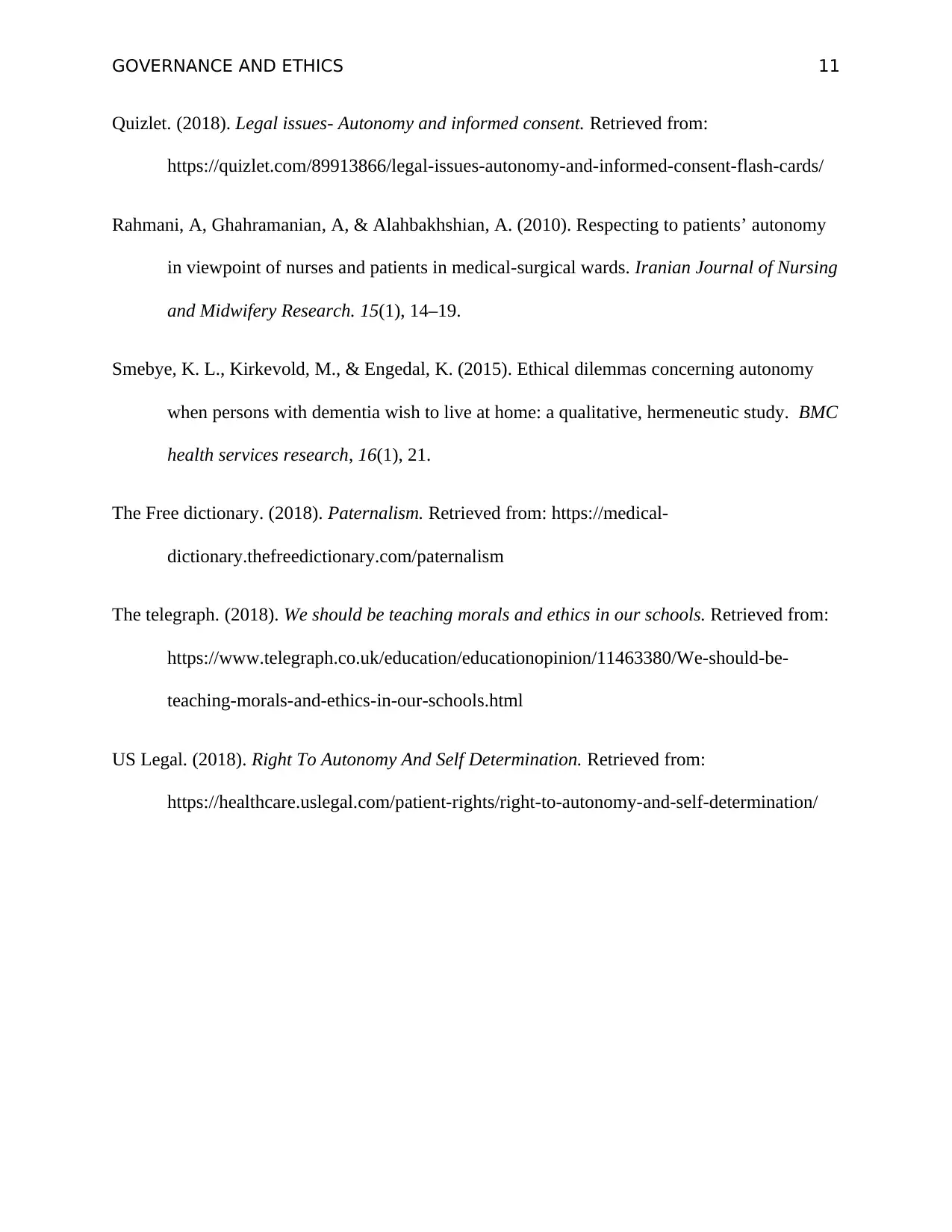
GOVERNANCE AND ETHICS 11
Quizlet. (2018). Legal issues- Autonomy and informed consent. Retrieved from:
https://quizlet.com/89913866/legal-issues-autonomy-and-informed-consent-flash-cards/
Rahmani, A, Ghahramanian, A, & Alahbakhshian, A. (2010). Respecting to patients’ autonomy
in viewpoint of nurses and patients in medical-surgical wards. Iranian Journal of Nursing
and Midwifery Research. 15(1), 14–19.
Smebye, K. L., Kirkevold, M., & Engedal, K. (2015). Ethical dilemmas concerning autonomy
when persons with dementia wish to live at home: a qualitative, hermeneutic study. BMC
health services research, 16(1), 21.
The Free dictionary. (2018). Paternalism. Retrieved from: https://medical-
dictionary.thefreedictionary.com/paternalism
The telegraph. (2018). We should be teaching morals and ethics in our schools. Retrieved from:
https://www.telegraph.co.uk/education/educationopinion/11463380/We-should-be-
teaching-morals-and-ethics-in-our-schools.html
US Legal. (2018). Right To Autonomy And Self Determination. Retrieved from:
https://healthcare.uslegal.com/patient-rights/right-to-autonomy-and-self-determination/
Quizlet. (2018). Legal issues- Autonomy and informed consent. Retrieved from:
https://quizlet.com/89913866/legal-issues-autonomy-and-informed-consent-flash-cards/
Rahmani, A, Ghahramanian, A, & Alahbakhshian, A. (2010). Respecting to patients’ autonomy
in viewpoint of nurses and patients in medical-surgical wards. Iranian Journal of Nursing
and Midwifery Research. 15(1), 14–19.
Smebye, K. L., Kirkevold, M., & Engedal, K. (2015). Ethical dilemmas concerning autonomy
when persons with dementia wish to live at home: a qualitative, hermeneutic study. BMC
health services research, 16(1), 21.
The Free dictionary. (2018). Paternalism. Retrieved from: https://medical-
dictionary.thefreedictionary.com/paternalism
The telegraph. (2018). We should be teaching morals and ethics in our schools. Retrieved from:
https://www.telegraph.co.uk/education/educationopinion/11463380/We-should-be-
teaching-morals-and-ethics-in-our-schools.html
US Legal. (2018). Right To Autonomy And Self Determination. Retrieved from:
https://healthcare.uslegal.com/patient-rights/right-to-autonomy-and-self-determination/
⊘ This is a preview!⊘
Do you want full access?
Subscribe today to unlock all pages.

Trusted by 1+ million students worldwide
1 out of 12
Related Documents
Your All-in-One AI-Powered Toolkit for Academic Success.
+13062052269
info@desklib.com
Available 24*7 on WhatsApp / Email
![[object Object]](/_next/static/media/star-bottom.7253800d.svg)
Unlock your academic potential
Copyright © 2020–2025 A2Z Services. All Rights Reserved. Developed and managed by ZUCOL.





